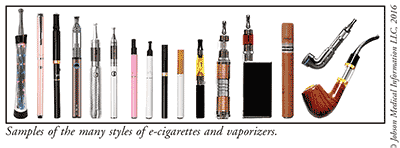US Pharm. 2016;41(7):13-14.
Electronic Nicotine Delivery System
Electronic cigarettes, or e-cigarettes, are devices that deliver concentrated nicotine in a vaporized aerosol by inhalation. The e-cigarette device consists of a power source (usually a rechargeable battery), a vaporizer (a heating device), and a cartridge filled with nicotine solution. E-cigarettes are often made to look like a tobacco cigarette, but they deliver nicotine without burning tobacco or creating smoke. As a result, they are considered by some to be a safer way to use nicotine. E-cigarettes have also been promoted as a tool to help people stop smoking tobacco cigarettes. Recently passed FDA regulations will require manufacturers of e-cigarettes to register their products and manufacturing facilities, add health warnings to their products and advertisements, and prohibit the sale of e-cigarettes to those younger than age 18 years.
Until Recently, E-Cigarettes Were Not Regulated

What Are E-Cigarettes?
E-cigarettes are a type of electronic nicotine delivery system, or ENDS, which looks similar to a cigarette and delivers nicotine in an aerosolized form when inhaled. Other nicotine delivery systems include e-cigars, e-pipes, e-hookahs, and similar devices made to look like pens or other everyday objects. There are hundreds of e-cigarette brands available in local shops and online. Until recently, these products have not been regulated by any government agency to insure their quality and safety.
The e-cigarette consists of a rechargeable power source, a heating device to vaporize the nicotine solution, and a cartridge (often refillable) that contains e-liquid. This liquid consists of nicotine (extracted from the tobacco plant) in a solution of chemicals, flavorings, and colorants. Typically, one end of the cartridge contains a mouthpiece that, when puffed on, activates the device to form vaporized nicotine, which is then inhaled. “Smoking” an e-cigarette is referred to as vaping.
Is Vaping Safe?
For most users of e-cigarettes, vaping is simply the recreational use of nicotine that does not involve burning tobacco. E-cigarettes are sometimes promoted as a smoking-cessation aid, but there are many other nicotine supplements proven both safe and effective in helping people stop their dependence on nicotine.
Safety concerns exist over the nicotine solutions used in e-cigarettes. These solutions are highly concentrated and deadly if swallowed. Less than a teaspoonful of nicotine solution would be fatal in an adult, and even less would be fatal to a child.
E-cigarettes are offered as a safer alternative to traditional tobacco cigarettes for a wide variety of reasons, not the least of which is exposure to less dangerous toxins than those found in tobacco smoke. However, nicotine is a highly addictive substance when inhaled, regardless of how it is delivered. Physical withdrawal from nicotine includes symptoms such as restlessness, anxiety, irritability, and depression. Nicotine has been proven harmful if used during pregnancy, both to the mother and to the development of the fetus. It has also been shown to interfere with brain development in teens.
Flavorings are often added to the concentrated nicotine solutions used in e-cigarettes. Although these flavor additives may be safe for food, they have not been tested for safety when inhaled. Many flavorings are either candy or fruit flavors, targeting marketing efforts toward teens.
The aerosol that is exhaled by e-cigarette users is not simple water vapor. It can contain nicotine as well as formaldehyde, acetaldehyde, and other toxic chemicals, making second-hand exposure to exhaled vapor potentially hazardous as well.
FDA Regulations
Until recently, ENDS devices had not been regulated by the FDA. The hundreds of e-cigarette products available in the U.S. have been manufactured and sold without inspection or oversight. Laboratory analysis has shown varying amounts of nicotine in the concentrated solutions sold for use in e-cigarette devices, often significantly different than labeled. Other toxic chemicals have been found in these nicotine solutions or nicotine cartridges, including formaldehyde, heavy metals, and diethylene glycol (a component of antifreeze).
The new FDA regulations will help ensure that the manufacture of these nicotine products will have oversight. Consumers of ENDS devices will be protected by requiring manufacturers to register their products and manufacturing facilities, seek authorization to sell their products, report the ingredients and their concentrations in e-liquids, and include health warnings on packaging and advertisements similar to those on other nicotine-containing products. The FDA has also updated their online tool to report problems with tobacco products, including e-cigarettes (www.safetyreporting.hhs.gov).
To comment on this article, contact rdavidson@uspharmacist.com.





